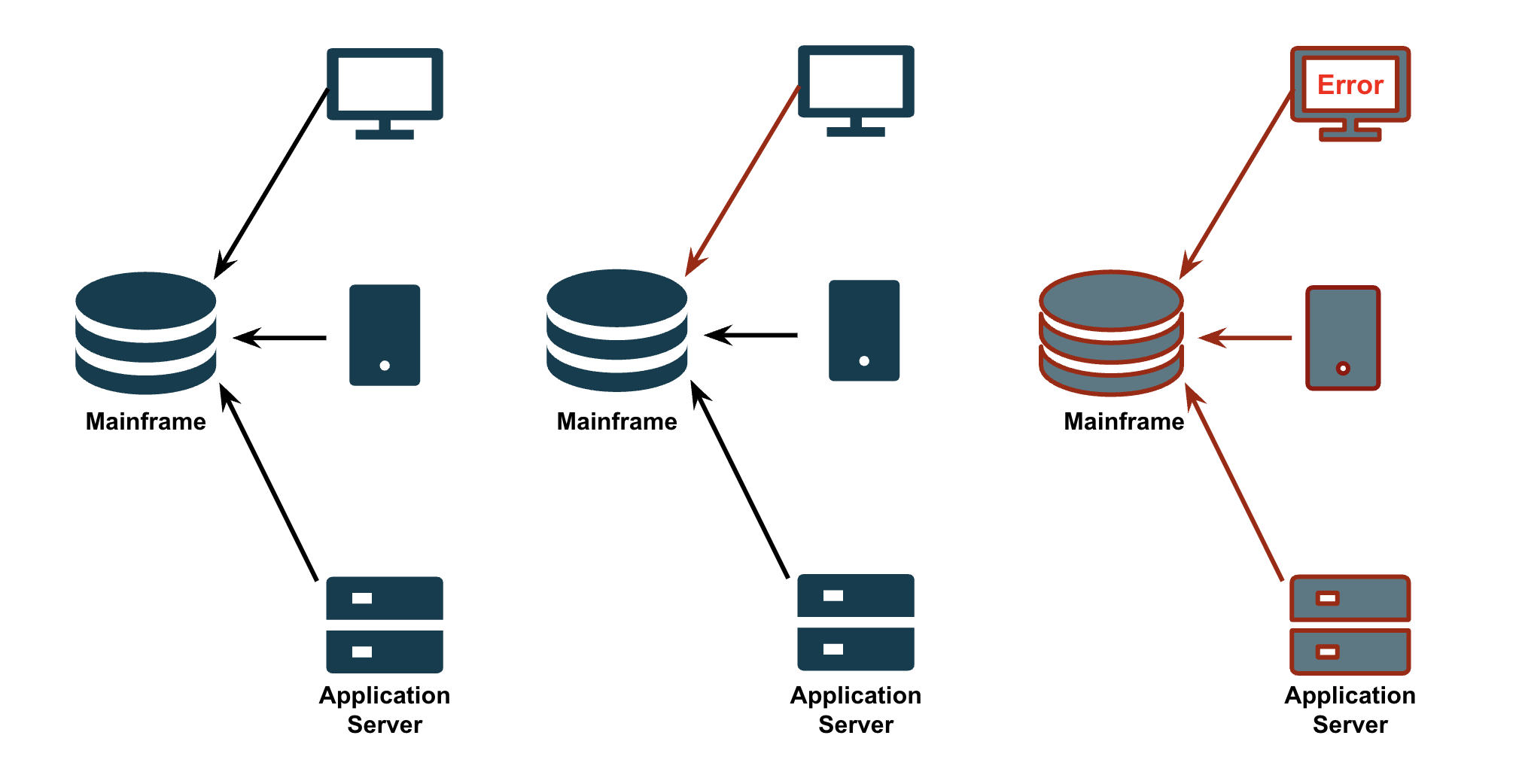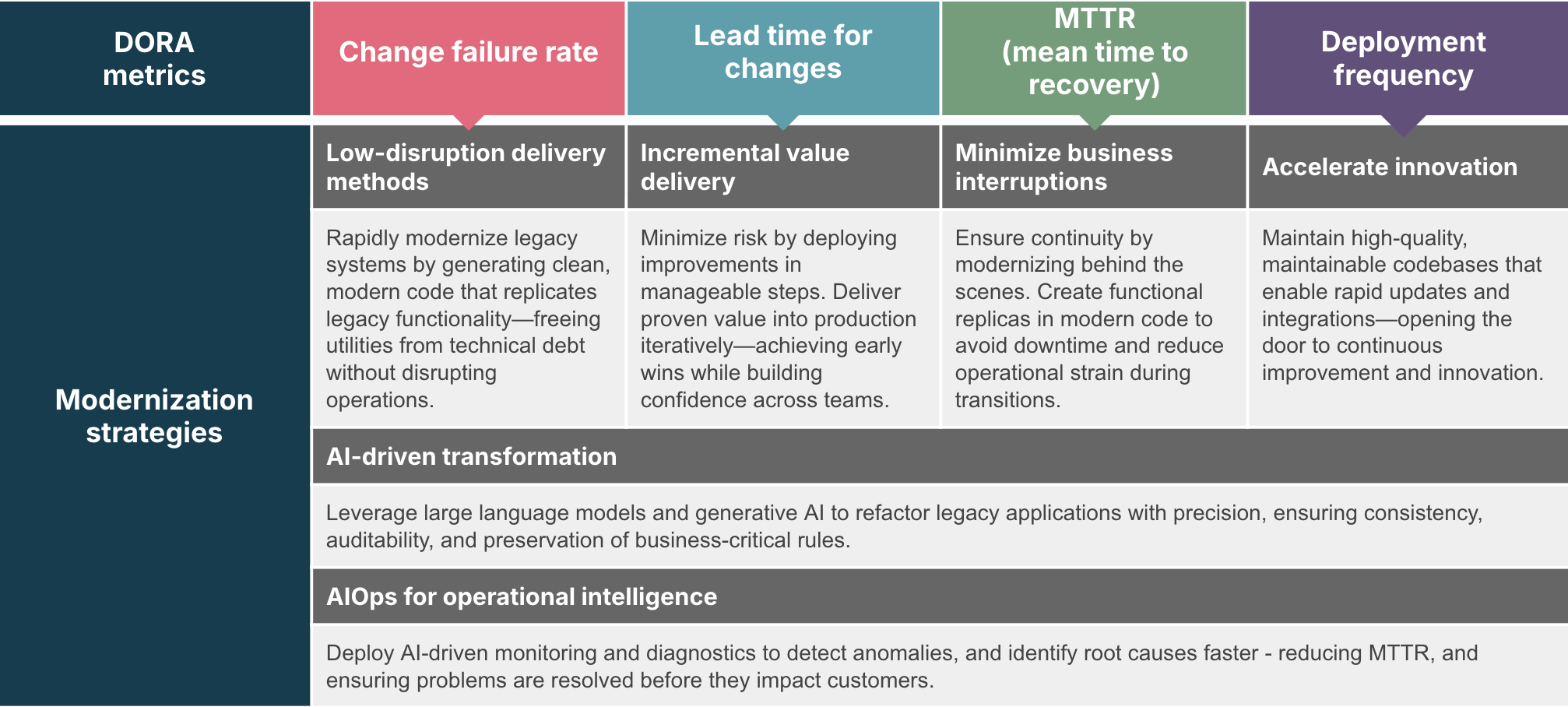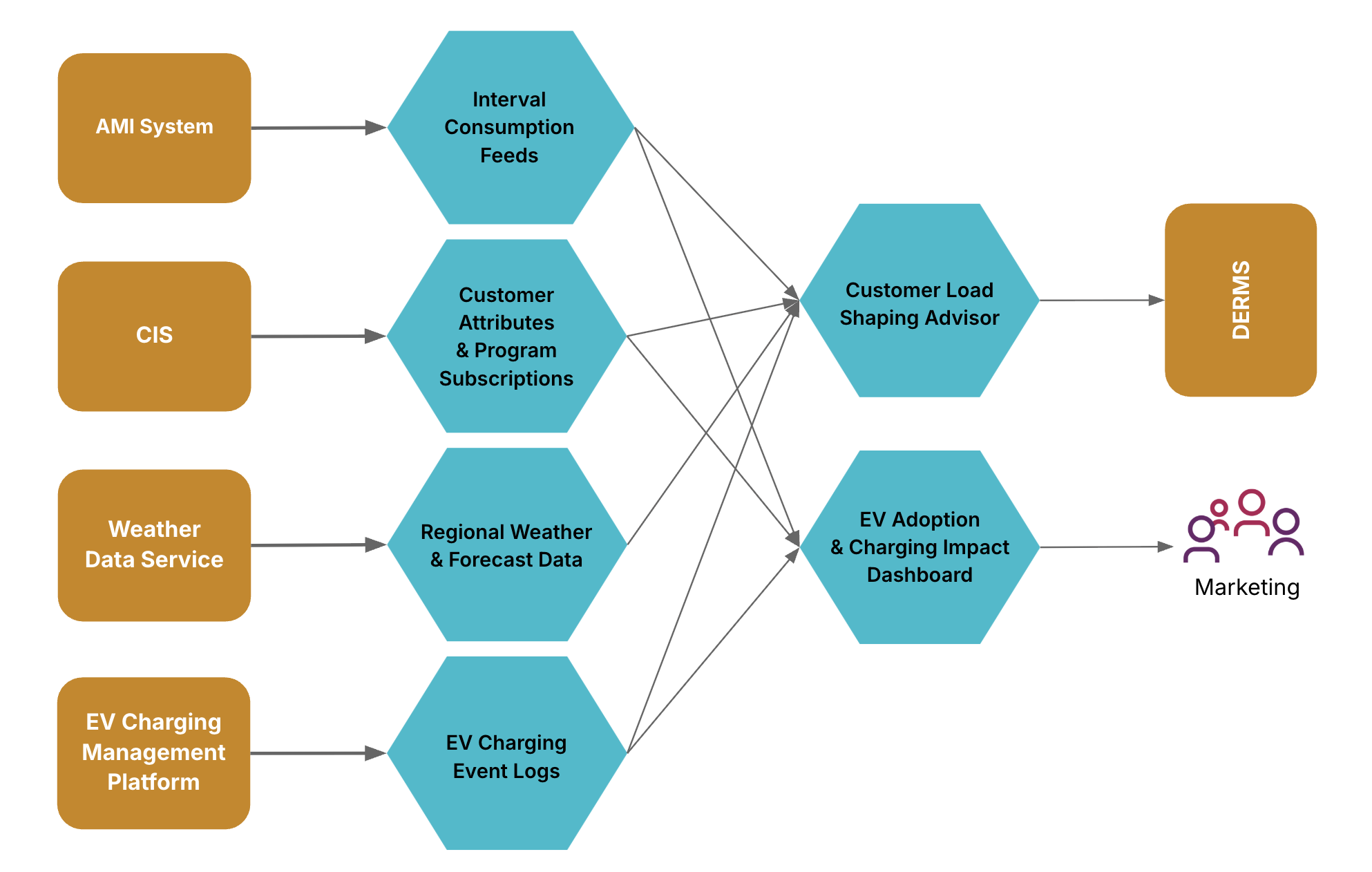Energy demand is rising. Reliability and resiliency are no longer differentiators—they’re the baseline. To meet these demands at scale, utilities must modernize IT through software innovation and integration—unlocking agility, efficiency, and affordability for both the business and its customers.
The global appetite for electricity is surging. From electric vehicles to smart homes and digitized industries, the demand for energy is not just growing—it's evolving. For utilities, this is a pivotal moment. The question is no longer if utilities should modernize, but how quickly they can get there.
This transformation demands bold, strategic thinking. Modernizing the grid, unlocking the value of data, and reimagining how utilities operate isn’t just smart business—it’s now a baseline requirement for resilience and relevance.
Modernization is no longer optional: Utilities must rethink IT, data and operations to keep up
Utilities must modernize aging IT systems and leverage data to meet rising electricity demand, optimize workflows, and lower risks and costs. This is not just a tagline—it’s the foundational strategy utilities must embrace to remain operationally resilient and financially viable in today’s energy landscape.
Much of the infrastructure in place today was designed for a past era: centralized generation, limited visibility, and predictable consumption patterns. But with the proliferation of electric vehicles, distributed energy resources, and fluctuating usage trends, the grid is facing pressures it was never originally built to handle.
Modernization efforts must include advanced metering infrastructure, grid automation, and digital control systems. These upgrades allow utilities to respond in real-time, automate workflows, and prevent outages before they happen. But technology alone isn’t the answer.
The real differentiator is data.
Smart infrastructure generates a wealth of insights—from load forecasts to equipment health and customer behavior. When harnessed correctly, this data becomes the fuel for predictive analytics, machine learning models, and automated decision-making. The result? Lower operational costs, reduced risk of downtime, and a grid that can flex and scale with evolving demand.
Utilities must treat modernization and data as a dual engine—not separate initiatives. Together, they unlock operational excellence, enable faster response times, and create a more adaptive, intelligent grid ready for the challenges ahead.
To ensure successful business outcomes, utilities must navigate the hurdles of modernizing systems and overcoming data silos
Modernizing systems is a complex undertaking—but the true friction lies in managing change across both technology and culture.
Utilities often operate within rigid, legacy environments. Systems don’t talk to each other. Data lives in silos. Business and IT teams operate in isolation. This fragmentation slows innovation and creates blind spots in decision-making.
To succeed, utilities must adopt integrated platforms, build cross-functional teams, and prioritize interoperability across systems and tools. They must also implement lightweight, purpose-driven governance frameworks that ensure data quality, security, and scalability—without slowing innovation.
Effective governance should be transparent, adaptable, and designed to spark conversation—not compliance for its own sake. Rules should be clear in their intent, open to challenge, and evolve through collaborative processes that promote shared ownership and continuous improvement.
The goal isn’t just modernization—it’s transformation. And transformation demands clarity, coordination, and a partner mindset across every layer of the organization.
Utilities must redefine how they use technology to power their business into the future
The utilities industry stands at a crossroads. Global electricity demand is rising fast, fueled by the electrification of heating, transport, and the rise of digital-first lifestyles. Rather than viewing this pressure as a threat, forward-thinking utilities see it as an opportunity—a moment to redefine how they operate.
Consumers today expect more. They want sustainable energy, seamless service, and transparent billing. This shift demands more than upgraded infrastructure. It requires a new mindset—one where utilities operate more like digital enterprises: agile, data-driven, and laser-focused on the customer experience.
Yet many current systems are ill-equipped to handle the scale, speed, and complexity of today’s energy data. From smart grid telemetry to customer engagement platforms, there’s massive value locked inside siloed, fragmented systems.
To stay competitive and sustainable, utilities must shift from reactive operators to proactive, tech-forward organizations. The ones that succeed will view rising demand not as a burden—but as a catalyst to modernize and reimagine what's possible.


Powering the future: A call to embrace legacy modernization and capitalize on data potential
The future of energy isn’t coming—it’s already here. It’s demanding more agility, intelligence, and foresight than ever before. For utilities, this is the moment to lead, not follow.
Modernizing systems and optimizing the way data is leveraged isn’t optional—it’s a business imperative. Utilities that invest today in smart infrastructure, unified data platforms, and digital workflows will be the ones who stay ahead of demand and shape the next era of the industry.
Leading organizations treat “data as a product”—governing, owning, and distributing data with the same rigor as software—ensuring it’s accessible, trustworthy, and designed to drive outcomes across the enterprise.
Start with a clear roadmap. Break down the silos. Equip your teams with the tools—and the capability—to act smarter and faster. That means investing not just in technology, but in the people who use it. Upskilling and training are critical to bridge the complexity gap, especially as advanced platforms and data tools become more integrated into everyday operations. Transformation only succeeds when everyone—from technical teams to frontline employees—has the confidence and context to use new tools effectively. It's also critical to work with technology partners who understand your challenges and can accelerate both the technical and human sides of your transformation journey.
There’s no shortcut to building a resilient, future-ready utility. Success depends on a clear, two-pronged strategy:
1. Modernize core systems: Upgrade aging enterprise applications and operational technology systems with scalable, cloud-enabled platforms, edge computing, and automation. Leverage modernization accelerators that replatform legacy code and critical applications with minimal risk—unlocking flexibility, interoperability, and long-term agility.
Design for recovery, not perfection: Shift your architectural mindset from preventing every failure to enabling fast, reliable recovery. Instead of optimizing for MTBF (Mean Time Between Failures), prioritize MTTR (Mean Time to Recovery)—the ability to detect, diagnose, and resolve issues quickly.
Modern platforms should emphasize ease of deployment, observability, rollback readiness, and rapid incident response. Every meaningful change carries some risk of bugs; the key is to acknowledge that reality and focus on how quickly issues can be surfaced and fixed without impacting customers or operations.
2. Data at scale: Break down silos and design scalable, decentralized data architectures that enable collaboration across the utility ecosystem—from grid sensors to billing systems to customer platforms. The goal isn’t to force everything into a single model, but to ensure systems can share, interpret, and act on data through well-defined interfaces and intentional integration patterns.
Empowered by strong governance and lightweight guardrails, this approach supports federated ownership while enabling enterprise-wide coordination. Embed AI, machine learning, and predictive analytics where it matters most—so every system becomes smarter and more responsive in real time.
Modernize core systems: How to transform utility systems without disruption
Modernizing core systems is essential for utilities aiming to remain agile, reliable, and customer-centric—but large-scale change doesn’t have to mean massive disruption. Leading utilities are proving it’s possible to modernize mission-critical IT and OT systems quickly and cost-effectively by rethinking how modernization is delivered.
Rather than rewriting from scratch, successful strategies focus on replatforming and refactoring legacy systems into scalable, modern architectures—while keeping operations stable and business logic intact.


These modernization practices align closely with engineering business frameworks and the DORA metrics—a proven foundation for measuring software delivery performance and resilience, but just the starting point for broader transformation thinking.
By embedding these principles, utilities can move faster, reduce risk, and unlock the full potential of their IT investments—while laying a measurable, scalable foundation for long-term resilience and innovation.
This client story details the technical approach and inner workings of a successful mainframe legacy system modernization. Our methodology enabled the seamless migration of 2.5 million users with no critical issues or downtime.
Data at scale: Our approach to breaking down silos and building reliable data platforms that power high-impact data products
In a modern utility, data is more than a byproduct—it’s a strategic asset. Yet too often, critical insights are trapped in isolated systems across operations, billing, grid telemetry, customer service, and regulatory reporting. The result? Fragmented decision-making, duplicated efforts, and missed opportunities to optimize.
To unlock real value, utilities must shift from siloed data warehouses to holistic, scalable platforms that treat data as a product—governed, discoverable, and built for business use.
Key pillars of this approach include:
Scalable self-service data platforms: Establish a cloud-native data foundation that ingests, transforms, and serves data across IT and OT environments—ensuring real-time availability and enterprise-wide visibility.
Data as a product mindset: Structure data domains around business outcomes. Assign ownership, enforce quality standards, and treat data pipelines with the same rigor as software—where every dataset is reliable, reusable, and built for impact.
- Interoperability & access control: Break down system silos with interoperable architectures that allow secure, role-based access to the right data at the right time—supporting operations, analytics, compliance, and innovation.
- Embedded intelligence: Power AI/ML models with clean, labeled, and contextualized data—fueling everything from demand forecasting and outage prediction to personalized customer engagement.
- Accelerated delivery: Use automation and modern data ops practices to rapidly design, test, and deploy new data products—enabling teams to respond faster to market, regulatory, and operational needs.
Utilities that embrace this approach don’t just centralize data—they operationalize it. The result is a responsive, intelligent organization that can act faster, innovate smarter, and deliver more value to customers and stakeholders.


Conclusion
Together, these levers form a powerful feedback loop: smarter systems generate better data, and better data continuously improves your systems. This is how utilities will move from reactive to predictive—and from fragmented to fully integrated.
The utilities sector is being redefined and powering the future requires bold leadership, decisive investment, and a relentless focus on innovation. Utilities have the opportunity, and the responsibility, to lead the way toward a more resilient, efficient, and sustainable energy ecosystem.
Don’t wait for disruption. Be the force that drives it.
Disclaimer: The statements and opinions expressed in this article are those of the author(s) and do not necessarily reflect the positions of Thoughtworks.















